汽车温度传感器5
- 格式:ppt
- 大小:858.00 KB
- 文档页数:21
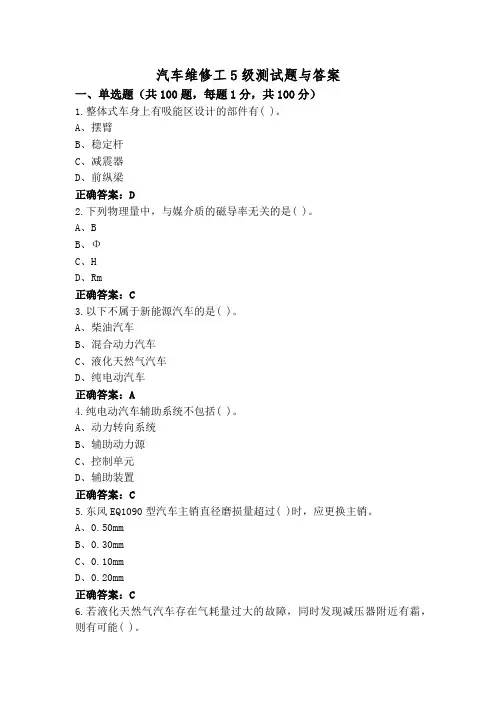
汽车维修工5级测试题与答案一、单选题(共100题,每题1分,共100分)1.整体式车身上有吸能区设计的部件有( )。
A、摆臂B、稳定杆C、减震器D、前纵梁正确答案:D2.下列物理量中,与媒介质的磁导率无关的是( )。
A、BB、ΦC、HD、Rm正确答案:C3.以下不属于新能源汽车的是( )。
A、柴油汽车B、混合动力汽车C、液化天然气汽车D、纯电动汽车正确答案:A4.纯电动汽车辅助系统不包括( )。
A、动力转向系统B、辅助动力源C、控制单元D、辅助装置正确答案:C5.东风EQ1090型汽车主销直径磨损量超过( )时,应更换主销。
A、0.50mmB、0.30mmC、0.10mmD、0.20mm正确答案:C6.若液化天然气汽车存在气耗量过大的故障,同时发现减压器附近有霜,则有可能( )。
A、减压器损坏B、气瓶压力过高C、混合器调整不当D、系统水循环管路存在堵塞正确答案:D7.液化天然气调压器阀体不能打开的故障不可能是( )A、燃气压力过低B、ECU无输出控制信号C、磁线圈故障,开启功率不足D、阀芯和铁芯配合间隙太小,阀芯不能自由滑动正确答案:A8.机油牌号中,在数字后面带有字母“W”的表示( )系列。
A、普通B、一般C、低温D、高温正确答案:C9.水泵由壳体、水泵轴、叶轮、轴承、水封和( )组成。
A、节温器B、上下水管C、散热器D、耦合器正确答案:B10.安装传动轴应从( )开始,逐步往后安装。
A、后端B、前端C、左端D、右端正确答案:B11.职业道德是指从事一定职业劳动的人们,在长期的职业活动中形成的( )。
A、行为规范B、劳动技能C、思维习惯D、操作程序正确答案:A12.当汽车负载上坡时,从离合器内散发出焦臭味或冒烟,属于摩擦式离合器( )故障的现象之一A、异响B、打滑C、分离不彻底D、发抖正确答案:B13.下列物理量中,与媒介质的磁导率无关的是( )。
A、BB、ΦC、HD、Rm正确答案:C14.在运动零件表面形成油膜,以减少磨损和功率损失,这是润滑油的( )作用。
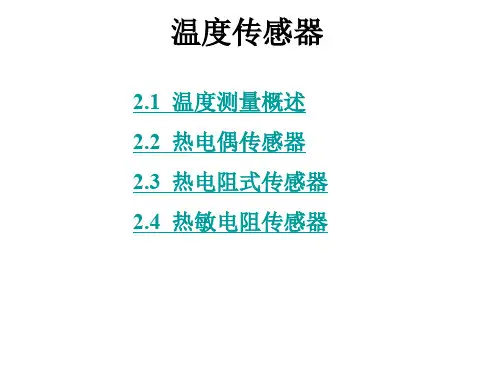
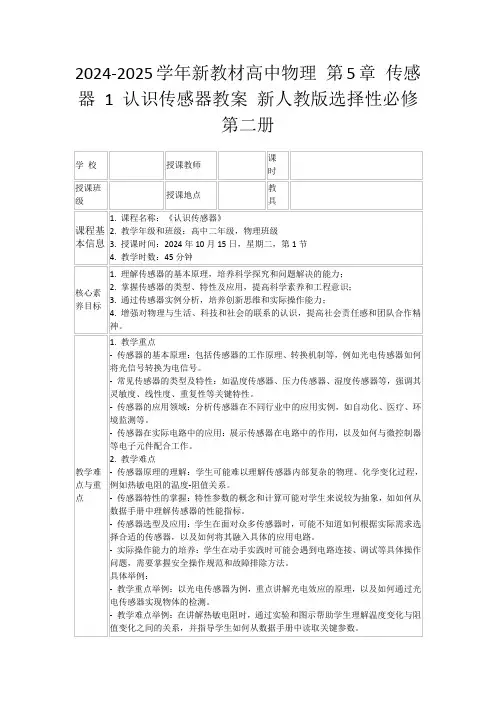
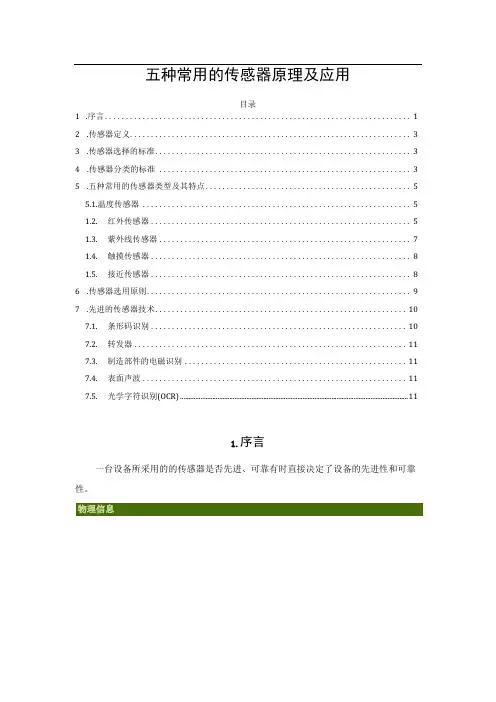
五种常用的传感器原理及应用目录1.序言 (1)2.传感器定义 (3)3.传感器选择的标准 (3)4.传感器分类的标准 (3)5.五种常用的传感器类型及其特点 (5)5.1.温度传感器 (5)1.2.红外传感器 (5)1.3.紫外线传感器 (7)1.4.触摸传感器 (8)1.5.接近传感器 (8)6.传感器选用原则 (9)7.先进的传感器技术 (10)7.1.条形码识别 (10)7.2.转发器 (11)7.3.制造部件的电磁识别 (11)7.4.表面声波 (11)7.5.光学字符识别(OCR) (11)1.序言一台设备所采用的的传感器是否先进、可靠有时直接决定了设备的先进性和可靠性。
图1传感器工作原理很多机械工程师在观念上有一个误区:机械工程师只负责机构的东西,传感器、电气元件选用及控制方案是电气工程师或系统工程师的事。
如果你是某个项目的总设计工程师,在方案构想阶段就要考虑到选用哪些类型的传感器以及设备的动作流程和控制方式。
生物信息:是反映生物运动状态和方式的信息。
碱基序列便是生物信息。
自然界经过漫长时期的演变,产生了生物,逐渐形成了复杂的生物世界。
生物信息形形色色,千变万化,不同类的生物发出不同的信息。
,人们对生物信息的研究已取得了一些可观的成果,人们发现,鸟有“鸟语”,兽有“兽语”,甚至花也有“花语”。
人们还发现生物信息与非生物信息之间有着某种必然的联系,如燕子、大雁的飞来飞去,预示着季节的变换和气温的升降;鱼儿浮出水面预示着大雨即将来临;动物的某些反常现象,预示着地震即将发生的信[息、******。
物理信息:包括声、光、颜色等。
这些物理信息往往表达了吸引异性、种间识别、威吓和警告等作用。
比如,毒蜂身上斑斓的花纹、猛兽的吼叫都表达了警告、威胁的意思。
萤火虫通过闪光来识别同伴。
红三叶草花的色彩和形状就是传递给当地土蜂和其它昆虫的信息。
化学信息:生物依靠自身代谢产生的化学物质,如酶、生长素、性诱激素等来传递信息。
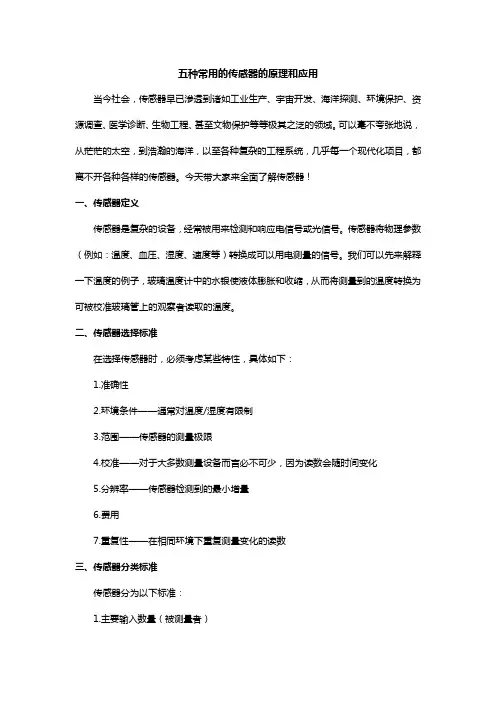
五种常用的传感器的原理和应用当今社会,传感器早已渗透到诸如工业生产、宇宙开发、海洋探测、环境保护、资源调查、医学诊断、生物工程、甚至文物保护等等极其之泛的领域。
可以毫不夸张地说,从茫茫的太空,到浩瀚的海洋,以至各种复杂的工程系统,几乎每一个现代化项目,都离不开各种各样的传感器。
今天带大家来全面了解传感器!一、传感器定义传感器是复杂的设备,经常被用来检测和响应电信号或光信号。
传感器将物理参数(例如:温度、血压、湿度、速度等)转换成可以用电测量的信号。
我们可以先来解释一下温度的例子,玻璃温度计中的水银使液体膨胀和收缩,从而将测量到的温度转换为可被校准玻璃管上的观察者读取的温度。
二、传感器选择标准在选择传感器时,必须考虑某些特性,具体如下:1.准确性2.环境条件——通常对温度/湿度有限制3.范围——传感器的测量极限4.校准——对于大多数测量设备而言必不可少,因为读数会随时间变化5.分辨率——传感器检测到的最小增量6.费用7.重复性——在相同环境下重复测量变化的读数三、传感器分类标准传感器分为以下标准:1.主要输入数量(被测量者)2.转导原理(利用物理和化学作用)3.材料与技术4.财产5.应用程序转导原理是有效方法所遵循的基本标准。
通常,材料和技术标准由开发工程小组选择。
根据属性分类如下:·温度传感器——热敏电阻、热电偶、RTD、IC等。
·压力传感器——光纤、真空、弹性液体压力计、LVDT、电子。
·流量传感器——电磁、压差、位置位移、热质量等。
·液位传感器——压差、超声波射频、雷达、热位移等。
·接近和位移传感器——LVDT、光电、电容、磁、超声波。
·生物传感器——共振镜、电化学、表面等离子体共振、光寻址电位测量。
·图像——电荷耦合器件、CMOS·气体和化学传感器——半导体、红外、电导、电化学。
·加速度传感器——陀螺仪、加速度计。
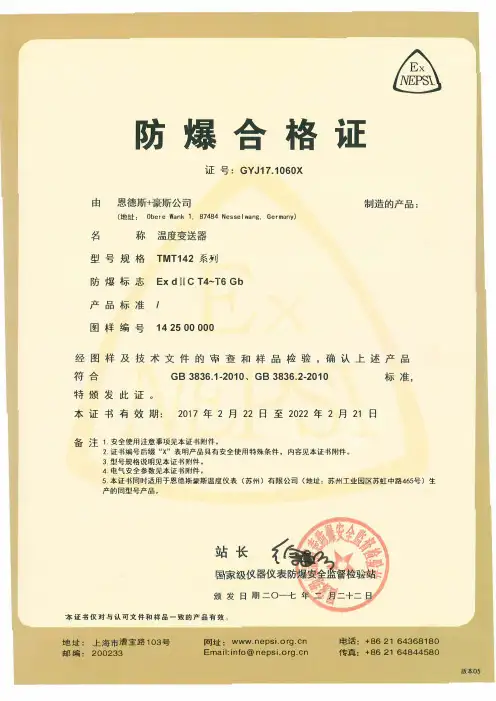
iiE -5: GYJ17.1060X(±t!!i.Jt: Obere Wank 1, 87484 Nesse Iwang, Germany)� -5 � � TMT142 *�UroJ ��;r-� ExdIICT4-T6GbIII�.$ UU -5 14 25 00 000GB 3836.1-2010, GB 3836.2-2010�� Wi � llt iiE 0* iiE � � � Wh 2017 � 2 � 22 B 3§: 2022 fF 2 � 21 B-fk 51 1. ��ffm)!�;rtnjlim*iiE�f!11i'f o2.iiE��%€*uxn.�F�A*���m ••• �. �.m*iiE�M�o3. �%��iJtajjm*iiE�f!11�o4. ������m*iiE�f!11�o5. *iiE�rii]ll1mmT!�.l�WT�wri.ffil.JJt f)(. (�#l) *��0'ii.l(±t!!t.il:: �#l.I�JJ!lm[R�!l!IIflIm465%) �Fßf,J��%F�ottf!:I:.It: »t3i: 1m 1 03-i5-JilB�: 200233 1XX.J:I:.It: Email:****************It!.ii!i: +8621 64368180fifa: +8621 64844580EXPLOSION PROTECTIONCERTIFICATE o F CONFORMITYCert NO.GYJ17.1060XThis is to certify that the productTemperature field transmittermanufactured by Endress + Hauser Wetzer GmbH + Co. KG(Address:Obere Wank 1,87484 Nesselwang, GerIllany)which model is TMT142 SedesEx marking Ex dUC T4�T6 Gbproduct standard /drawing number 142500000has been inspected and certified by NEPSI, and that it conformsto GB 3836.1-2010,GB 3836.2-2010This Approval shall remain in force until 2022.02.21Remarks l.Conditions for safe use are specified in the attachment(s) to this certificate.2.Symbol X placed after the certification lIumber denotes specific conditions of use,which are specified in the aHachment(s) to this certificate.3.Model designation is specified in the attachment(s) to this ccrtificate.4.lntrinsic safety parameters specified in the attachment(s) to this cert.ificate.5.Thi s certificate i also applicable for the product with the same type manufactured byEndress+Hauser Wetze I'(Suzhou) Co., Ltd. (address: Su Hong Zhong Lu No.465,S u z hou-S IP, China)DirectorIsslJed DateThis Certificate is valid for products compatible with the documents and sam p ies approved by NEPSI.103 C ao Bao Road Shanghai200233,China Email: **************.cnTel: +862164368180Fax: +8621 64844580Edition 05�*ätt�tt��.*�����M National Supervision and Inspection Centre forExplosion Protection and Safety of Instrumentation(GYJ17.1060X) (Attachment I )EI3 }ß(1i&, JtIT + � ftJT -0 i§j 1:F (:11 T MT 142� �� 11fi'tJ1t 11!:�.f.�, � � % � 15( .f.HX. $: r�:lI:tc � 1lil �fft�ftft�(NEPSI);j§:�, r1:il-r ��fff-{jt:G83836.1-2010 mHfl l 7}: 15i:� jjfiffl�* G83836.2-201 0 :lItftl::E1�Jfi m2tfß7t: EI3 ��:J:I5'�)t "d" 1!-iHf' 811& �F J'b IlJJ :J:I fff-;=.t;Ex d II e T 4� T 6 Gb, �}j:ll il-*friiE -'%GY J 17.1 060Xo;2js:iiE �I� iA pJ 81 F Jf� lli -'% �.m*fr :im r :iTEMP HART TMT 142-30;!tr:I': 0$::1J\5'�%, �EJ.�.!F) I A�E\ m;:6:i!}:t:w., ii(; �FJjH.l\l�;fri�HJ.J 450-, F � ��-ß!!ffl *f 7'l�ftj:F�'bllh13il-*itiiE-'% )§� "X" 1J..1*�J?g:�llr:�R�.mil-®��.���F���%o=,F��fflY3:�.J.]lt1, Fn�:7�:Jti&�m!tJ1.ftIlij-=f, JtJ?tJ-=.��{fJi�Ui·m.PJ$m±-tl!.o2, FrI'b]*************:1v40Vdc o3, FR,d!tJfJ 31�J5i�\frßt�D11fi't }JUJHJ � 81*�:11ü\.]}t�JHJIjT 6 T 5 �1.t11ffi.J1t -40'C �+55'C -40'C�+70'C T4 -40'C �+85'C�ffffl��'i\1EUjti@J-=f 65'C, 4, F Jfb 81 Il!. �� 51 A D 5'Z �cffl � �}j:J:I;j§:� iA pT �, �{fil-G83836.1-201 O �II G83836.2-2010B1*J\!�, B.�}j:J:I��Ex d IIe Gba"J�>��JOJ\!*fr:1v1/2NPT (EI.x;M20X 1.5) B1tt!.��5I A'l& iI 0 7L� .EJ.�� 51 A D 5'Z*ffl �;§5'ZIlJJ :lI �� 05,FJfb����ffl.����m�"���§H�"���o6, ffl):Ct :f�� EI 1TI�!L����F Jfb 81 ftJ/=t-*t1'�1�:, m.� �1djj Uif�(rt1;t fPJfo zn';R:lE1T 9=t I±\���., ��.�IlJJ .tt��m��.���o(GY J17.1 060X) (Attachment I )7, F �,E11�9t, 1.l!!ffl*11�1Hf' e'Z1fD n,Jit'<i' FJjH�ffl �ryj �I];, G83836.13-2013 ";t�Hf.U:Jq� J5't m13tfß7t: if>(:�811Iir.lli,�11i, 11i�*I]�m" , G83836.15-2000 ":Ii�f.tl:4:1*:JqdJifflE@. l=t.&� m15$7t: mJfLthFf r4:!.4:�� CmWllil1l-) " , G83836.16-2006 ":Ii�tn4:1*�1:t ffl �4: -&�%16ttrl7t: C �Jffr�i�"') .&.G850257 -2014 "i4J.4:if;( ��9&I�.��*������4:9& ••1,F���r������mtt •• ��AF��ru���;2, tM Jilt r �, �1i1 JIli 1:ir tt: )10-N E P S l'lA 81 -x.1tJ: 'ti :t4 t" ;3, t" r.f b� il t! rp e'Z � Y � 3>-5 -F 31� i*J � :a)N EPS I-lAWJ:fj]\fit;b) F Jjt"ljj� :fj]\ fit;c) ll1J � ß-1:t'riiE -'%d ) 1!f: Ji=J � ±JUili't }j[ffil*�{)(�{)(��.1<�lI{t'l��M National Supervision and Inspection Centre forExplosion Proteetion and Safety of InstrumentationG YJ17.1060X) A ttachment I )Attachment I to GYJ17.1060X1. DescriptionTMT142 series Temperature field transmitter, manufactured by Endress+Hauser Wetzer GmbH + CO.I<G, has been certified by National Supervision and Inspection Center for Explosion Protection and Safety of Instrumentation (NEPSI). The product accords with following standards:G83836.1-2010 Explosive atmospheres-Part 1: Equipment-General requirementsG83836.2-2010 Explosive atmospheres-Part 2: Equipment protection by flameproof enclosure"d"The Ex marking is Ex d n C T 4-T6 Gb, its certificate number is GY J17.1 060X.Type approved in this certificate is shown as the following:iTEMP HART T M T142-3 0o indicates enclosure, cable entry, configuration connection and etc.Refer tü instruction manual for tl16 details.2. Special Conditions for Safe UseThe suffix "X" placed after the certificate number indicates that this product is subject to special conditions for safe use, that is:For information on the dimensions of the flameproof joints contact the manufacturer.3. Conditions for Safe Use3.1 The external earth connection facility of this product shall be connected reliably.3.2 Electrical data: 40 Vdc.3.3 The relationship between ambient temperature range and the temperature class is shown as foliows:Temperature class T6 T5 T4Ambient temperature range -40°C-+55°C -40°C-+ 70°C -40'C-+85°CUse the connection cable endurance to he a t at least 90°C when the ambient temperature is > 65°C.3.4 Suitable certified cable glands or blanking plugs for unused holes ('1/2 NPT or M20*1.5) approved by ExTL according to G83836.1-201 0 and G83836.2-2010 with Ex marking "Ex d II C Gb" shall be used and correctly installed. The cable glands and blanking plugs to be used shall suitable for the product working conditions.Page 1 of 2G Y J17.1 060X) A ttachment I )3.5 Any maintenance shall be performed only when the warning of "00 not open when energized" is obseNed.3.6 The user shall not change the configuration in order to maintain/ensure the explosion protection performance of the equipment. Any change may impair safety.3.7 For installation, use and maintenance of this product, the end user shall obseNe the instruction manual and the following standards:GB50257 -2014 "Code for construction and acceptance of electric device for explosion atmospheres and fire hazard electrical equipment installation engineering".GB3836.13-2013 "Explosive atmospheres-Part 13:Equipment repair, overhaul and reclamation".GB3836.15-2000 "Electrical apparatus for explosive gas atmospheres-Part 15:Electrical installations in hazardous area (other than mines)".GB3836.16-2006 "Electrical apparatus for explosive gas atmospheres-Part 16: I nspection and maintenance of electrical installation (other than mines)".4. Manufacturer's Responsibility4.1 Conditions for safe use, as specified above, should be included in the documentation the user is provided with ..4.2 Manufacturing shoulcl be done according to the documentation approved by NEPSI.4.3 Nameplate should include these contents listed below:1) NEPSl logo @2) Ex marking3) certificate number4) ambient temperature5) warning of "00 not open when energized"Page 2 of 2。
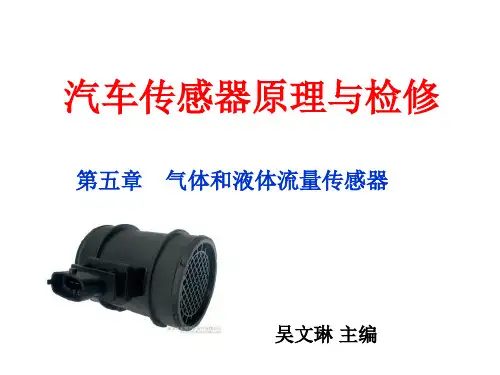
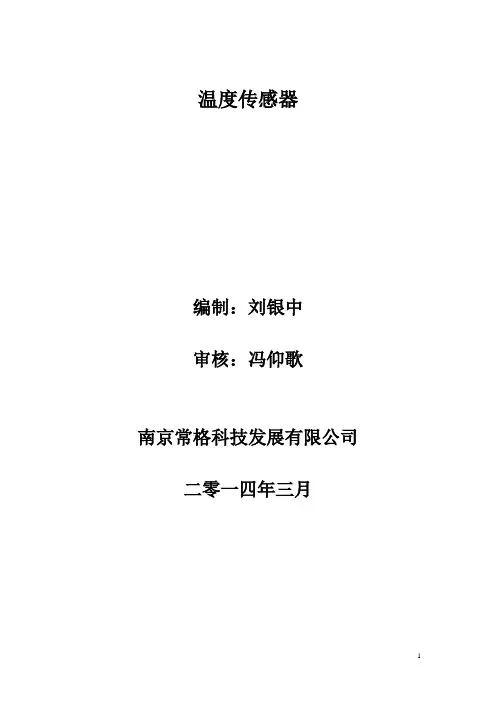
温度传感器编制:刘银中审核:冯仰歌南京常格科技发展有限公司二零一四年三月温度传感器目录一、温度传感器简介 (3)二、温度传感器主要分类 (3)1、接触式温度传感器 (3)2、非接触式温度传感器 (4)三、热电阻温度传感器的组成及原理 (5)1 温度传感器的组成 (5)2、热电阻的工作原理 (5)四、PT100的原理 (6)1、pt100的基本结构: (6)2、pt100的分度值: (7)3、pt100的结构: (7)4、pt100的性能 (7)五、电路设计 (8)1、采样电路设计 (8)2、放大电路设计 (9)3、模拟仿真电路 (10)六、数据库的建立 (10)七、参数及计算 (13)八、热电阻温控器接线 (14)九、温度传感器主要品牌及价格 (16)十、检定装置及法律法规 (17)十一、挑选方法 (18)1、热电偶 (18)2、热敏电阻 (19)十二、选用注意 (19)十三、安装使用 (20)一、温度传感器简介温度传感器从17世纪初人们开始利用温度进行测量。
在半导体技术的支持下,本世纪相继开发了半导体热电偶传感器、PN结温度传感器和集成温度传感器。
与之相应,根据波与物质的相互作用规律,相继开发了声学温度传感器、红外传感器和微波传感器。
温度传感器是五花八门的各种传感器中最为常用的一种,现代的温度传感器外形非常得小,这样更加让它广泛应用在生产实践的各个领域中,也为人们的生活提供了无数的便利和功能。
温度传感器有四种主要类型:热电偶、热敏电阻、电阻温度检测器(RTD)和IC温度传感器。
IC温度传感器又包括模拟输出和数字输出两种类型。
温度传感器二、温度传感器主要分类1、接触式温度传感器接触式温度传感器的检测部分与被测对象有良好的接触,又称温度计。
温度计通过传导或对流达到热平衡,从而使温度计的示值能直接表示被测对象的温度。
一般测量精度较高。
在一定的测温范围内,温度计也可测量物体内部的温度分布。
但对于运动体、小目标或热容量很小的对象则会产生较大的测量误差,常用的温度计有双金属温度计、玻璃液体温度计、压力式温度计、电阻温度计、热敏电阻和温差电偶等。
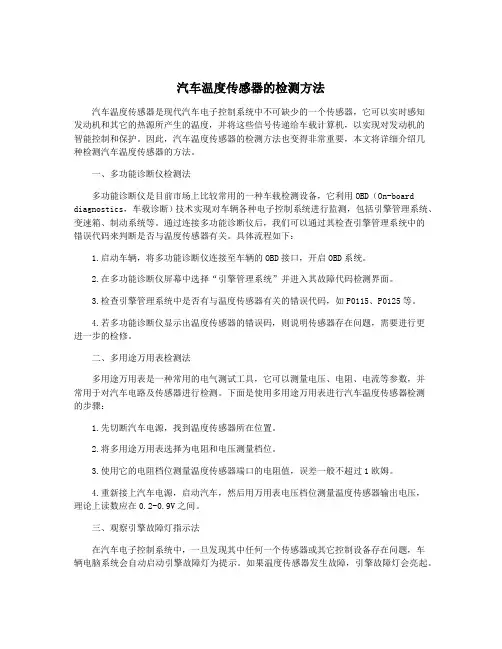
汽车温度传感器的检测方法汽车温度传感器是现代汽车电子控制系统中不可缺少的一个传感器,它可以实时感知发动机和其它的热源所产生的温度,并将这些信号传递给车载计算机,以实现对发动机的智能控制和保护。
因此,汽车温度传感器的检测方法也变得非常重要,本文将详细介绍几种检测汽车温度传感器的方法。
一、多功能诊断仪检测法多功能诊断仪是目前市场上比较常用的一种车载检测设备,它利用OBD(On-board diagnostics,车载诊断)技术实现对车辆各种电子控制系统进行监测,包括引擎管理系统、变速箱、制动系统等。
通过连接多功能诊断仪后,我们可以通过其检查引擎管理系统中的错误代码来判断是否与温度传感器有关。
具体流程如下:1.启动车辆,将多功能诊断仪连接至车辆的OBD接口,开启OBD系统。
2.在多功能诊断仪屏幕中选择“引擎管理系统”并进入其故障代码检测界面。
3.检查引擎管理系统中是否有与温度传感器有关的错误代码,如P0115、P0125等。
4.若多功能诊断仪显示出温度传感器的错误码,则说明传感器存在问题,需要进行更进一步的检修。
二、多用途万用表检测法多用途万用表是一种常用的电气测试工具,它可以测量电压、电阻、电流等参数,并常用于对汽车电路及传感器进行检测。
下面是使用多用途万用表进行汽车温度传感器检测的步骤:1.先切断汽车电源,找到温度传感器所在位置。
2.将多用途万用表选择为电阻和电压测量档位。
3.使用它的电阻档位测量温度传感器端口的电阻值,误差一般不超过1欧姆。
4.重新接上汽车电源,启动汽车,然后用万用表电压档位测量温度传感器输出电压,理论上读数应在0.2-0.9V之间。
三、观察引擎故障灯指示法在汽车电子控制系统中,一旦发现其中任何一个传感器或其它控制设备存在问题,车辆电脑系统会自动启动引擎故障灯为提示。
如果温度传感器发生故障,引擎故障灯会亮起。
因此,观察引擎故障灯的指示情况也是一种有效的汽车温度传感器检测方法。
具体操作如下:1.检查车辆引擎故障灯是否亮起,一般故障灯亮起后车载电脑会存储一个有关错误码,可以通过OBD读取。
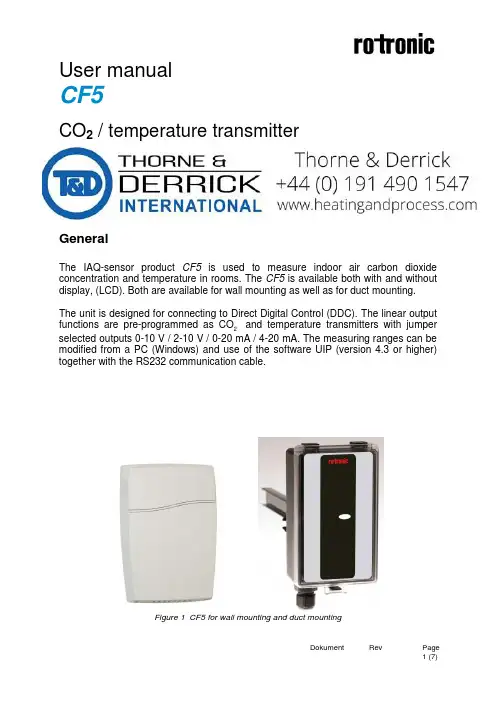
User manualCF5CO2 / temperature transmitterGeneralThe IAQ-sensor product CF5 is used to measure indoor air carbon dioxide concentration and temperature in rooms. The CF5 is available both with and without display, (LCD). Both are available for wall mounting as well as for duct mounting.The unit is designed for connecting to Direct Digital Control (DDC). The linear output functions are pre-programmed as COand temperature transmitters with jumper2selected outputs 0-10 V / 2-10 V / 0-20 mA / 4-20 mA. The measuring ranges can be modified from a PC (Windows) and use of the software UIP (version 4.3 or higher) together with the RS232 communication cable.Figure 1 CF5 for wall mounting and duct mountingTerminal DefaultOutput Default OutputRangeOutputs of thissensorOutput Range ofthis sensorOut(1) 0-10VDC 0-2000 ppm CO2Out(2) 0-10VDC 0-50 o CTable I. Default output configurations for CF5 Formulas for calculation of output values Configuration Output Range Formula for calculation0-10 VDC 0-2000 ppm CO20-50 o C CO2 value = Volt/10*2000 Temperature value in o C = Volt/10*502-10 VDC 0-2000 ppm CO20-50 o C CO2 value = (Volt –2)/8*2000 Temperature value in o C = (Volt –2)/8*504-20 mA 0-2000 ppm CO20-50 o C CO2 value = (mA-4)*2000/16 Temperature value in o C = (mA-4)*50/16a-b c–d Value = (reading-a)/(b-a)*(d-c)+ca = lowest value of the configurationb = highest value of the configurationc = lowest value of the ranged = highest value of the rangeTable II. Calculation of CO2 value and temperature value for CF5Output ConfigurationsThe sensors/controllers are supplied from the factory (unless otherwise ordered) with 0...10VDC linear outputs for Out(1) and Out(2)(see Table I). If other options are needed for the application, the output jumpers have to be configured before the unit is powered up. Each jumper selection is independent from the others, except for the “Start point selection” jumper, which affects both Out(1) and Out(2)linear outputs. Alternative measuring ranges of the outputs can be selected with the software UIP (version 4.3 or later).Jumper Position FunctionStart point selection jumper0%20%Jumper top position provides 0Vdc or 0mA start point for Out(1), Out(2)(0-20mA or 0-10V).Jumper bottom position provides 2Vdc or 4mA start point for Out(1), Out(2) (4-20mA or 2-10V).NOTE! The start point jumper is missing on some models!Out(1)CurrentVoltage Connection in position “Current” provides 0/4-20mA output range for Out(1). Current output is not recommended for temperature measurements Connection in position “Voltage” provides 0/2-10VDC output range for Out(1). Please note! Temperature measurements accuracy is valid only for units configured in voltage outputs mode.Out(2)CurrentVoltage Connection in position “Current” provides 0/4-20mA output range for Out(2). Current output is not recommended for temperature measurements Connection in position “Voltage” provides 0/2-10VDC output range for Out(2). Please note! Temperature measurements accuracy is valid only for units configured in voltage outputs mode.Table II. Configuration jumpers for CF5Self-diagnosticsThe system contains complete self-diagnostic procedures. A full system test is executed automatically every time the power is turned on. In addition, constantly during operation, the sensor probes are checked against failure by checking the valid dynamic measurement ranges. All EEPROM updates, initiated by the sensor itself, as well as by external connections, are checked by subsequent memory read back and data comparisons.These different system checks return error bytes to the system RAM. The error codes are available by connecting a PC with a special RS232 cable connected to the UART port slide connector. The error codes are shown in the software UIP (version 4.3 or later). Warm up and Out of Range are the only bits that are reset automatically after return to normal state. All other error bits have to be reset manually after return to normal by power off/on.The yellow LED flashes if an error has been detected. If a fatal error has been detected the yellow LED is lit.Error code and action planBit # ErrorcodeError description Suggested action0 N/A Fatal Error Try to restart sensor by powerOFF/ON. Contact local distributor 1 2 Reserved2 4 Algorithm Error.Indicate wrong EEPROMconfiguration. Try to restart sensor by power OFF/ON.Check detailed settings and configuration with UIP software version 4.3 and higher. Contact local distributor.3 8 Output ErrorDetected errors during outputsignals calculation andgeneration. Check connections and loads of outputs.Check detailed status of outputs with UIP software version 4.3 and higher.4 16 Self-Diagnostic Error.May indicate the need of zerocalibration or sensorreplacement. Check detailed self-diagnostic status with UIP software version 4.3 and higher.Contact local distributor5 32 Out Of Range ErrorAccompanies most of othererrors. Can also indicateoverload or failures of sensorsand inputs.Resets automatically aftersource of error disappearance. Try sensor in fresh air.Check connections of temperature and relative humidity probe. Check detailed status of measurements with UIP software version 4.3 and higher.See Note 1!6 64 Memory ErrorNon-fatal error during memoryoperations. Check detailed settings and configuration with UIP software version 4.3 and higher.7 128 Warm Up stateIs always set after power up orpower failure. Resets afterrestart sequence. If it doesn’t disappear in half a minute, check power stability.Note 1. Any probe is out of range. Occurs, for instance, during over exposure of CO2 sensor, in which case the error code will automatically reset when the measurement values return to normal. Could also indicate the need of zero point calibration. If the CO2 readings are normal, and still the error code remains, the temperature sensor can be defect or the connections to it are broken.Remark:If several errors are detected at the same time the different error code numbers will be added together into one single error code!PLEASE NOTE!The sensor accuracy is defined at continuous operation (at least 3 weeks after installation)MaintenanceThe CF5is basically maintenance free. An internal self-adjusting calibration function takes care of normal long term drift associated to the CO2sensor. To secure the highest accuracy, a time interval of five years is recommended between CO2 calibrations, unless some special situations have occurred. A zero calibration can be performed by use of pure nitrogen or air that has passed through a chemical absorber and a PC together with the UIP software version 4.3 (or higher). The Service bag can be used to produce carbon dioxide free air. The software can be free downloaded from . The RS232-cable and the zero calibration bag can be ordered from Rotronic. The cable is to be connected to the UART port slide connector (see Fig. 5). For change of control parameters and re-calibration (CO2 and temperature) this PC tool has to be used. The check can be done on site without interfering with the ventilation system.This is for sensors with measuring ranges between 0-3000 ppm and 0-4%: When a zero calibration shall be executed a plastic tube with 2,2 mm outer diameter and 0,8 mm inner diameter shall be inserted in marked holes of the sensor. Plastic tubing is connected to the tube. The gas flow should be between 0,3 and 1,0 l/min. Array Figure 2 Part of the PCB with holes for gas inlets marked.Duct mountingIf for some reason the printed circuit board (PCB) needs to be removed, special precaution must be taken in order not to damage the temperature probe in the sampling tube. When putting the PCB back in the protective housing, the probe mustbe gently positioned in the sampling tube.+This product is in accordance with theEMC 2004/108/EC, 92/31/EEGincluding amendments by the CE-marking Directive 93/68/EEC The product fulfils the following demands:EN 61000-4-2 level 2,EN 61000-4-3 level 2,EN 61000-4-4 level 4,EN 61000-4-6,EN 61000-4-8 level 4,EN 55022 class B。
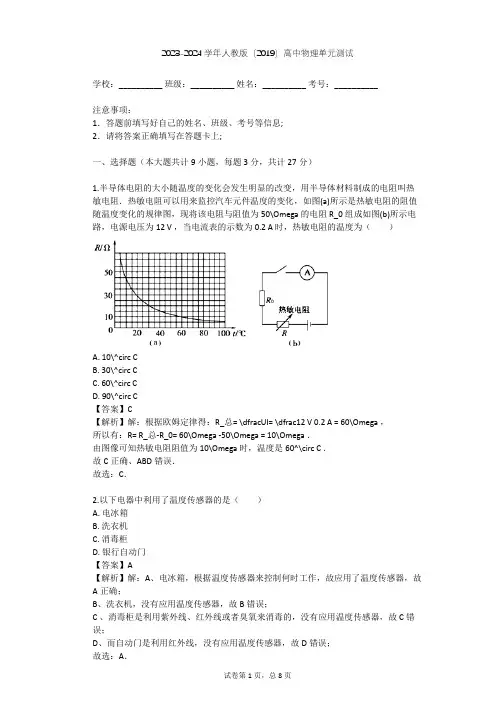
2023-2024学年人教版(2019)高中物理单元测试学校:__________ 班级:__________ 姓名:__________ 考号:__________注意事项:1.答题前填写好自己的姓名、班级、考号等信息;2.请将答案正确填写在答题卡上;一、选择题(本大题共计9小题,每题3分,共计27分)1.半导体电阻的大小随温度的变化会发生明显的改变,用半导体材料制成的电阻叫热敏电阻.热敏电阻可以用来监控汽车元件温度的变化,如图(a)所示是热敏电阻的阻值随温度变化的规律图,现将该电阻与阻值为50\Omega 的电阻R_0组成如图(b)所示电路,电源电压为12 V ,当电流表的示数为0.2 A 时,热敏电阻的温度为()A. 10\^circ CB. 30\^circ CC. 60\^circ CD. 90\^circ C【答案】C【解析】解:根据欧姆定律得:R_总= \dfracUI= \dfrac12 V 0.2 A = 60\Omega ,所以有:R= R_总-R_0= 60\Omega -50\Omega = 10\Omega .由图像可知热敏电阻阻值为10\Omega 时,温度是60^\circ C .故C正确、ABD错误.故选:C.2.以下电器中利用了温度传感器的是()A. 电冰箱B. 洗衣机C. 消毒柜D. 银行自动门【答案】A【解析】解:A、电冰箱,根据温度传感器来控制何时工作,故应用了温度传感器,故A正确;B、洗衣机,没有应用温度传感器,故B错误;C 、消毒柜是利用紫外线、红外线或者臭氧来消毒的,没有应用温度传感器,故C错误;D、而自动门是利用红外线,没有应用温度传感器,故D错误;故选:A.3.2007年度诺贝尔物理学奖授予了法国和德国的两位科学家,以表彰他们发现“巨磁电阻效应”.基于巨磁电阻效应开发的用于读取硬盘数据的技术,被认为是纳米技术的第一次真正应用.在下列有关其它电阻应用的说法中.错误的是()A. 热敏电阻可应用于温度测控装置中B. 光敏电阻是一种光电传感器C. 电阻丝可应用于电热设备中D. 电阻在电路中主要起到通直流、阻碍交流的作用【答案】D【解析】解: A.热敏电阻的原理是通过已知某电阻的电阻值与温度的函数关系,测得该热敏电阻的值即可获取温度,从而应用于温度测控装置中, A说法正确;B.光敏电阻是将光信号与电信号进行转换的传感器, B说法正确;C.电阻丝通过电流会产生热效应,可应用于电热设备中, C说法正确;D.电阻对直流和交流均起到阻碍的作用, D说法错误.故选 D.4.如图是一火警报警电路的示意图,其中R_3为用某种材料制成的传感器,这种材料的电阻率随温度的升高而增大.值班室的显示器为电路中的电流表,电源两极之间接一报警器.当传感器R_3所在处出现火情时,显示器的电流I、报警器两端的电压U的变化情况是()A. I变大,U变小B. I变小,U变大C. I变大,U变大D. I变小,U变小【答案】C【解析】解:当传感器R_3所在处出现火情时,R_3的阻值增大,外电路总电阻增大,根据闭合电路欧姆定律可得,干路电流减小,路端电压变大,即报警器两端的电压U变大;R_3与R_2并联部分两端的电压变大,故显示器的电流I变大, C正确.故选 C.5.下列说法错误的是()A. 温度传感器通常是利用物体的某一物理性质随温度的变化而改变制成的B. 红外线传感器接收携带着信息的红外线,转换成电信号,从而得知辐射源的相关信息C. 目前常用的传感器有温度传感器、生物传感器、及压力传感器等D. 热敏电阻是由绝缘材料制成的电阻器,其电阻值会随温度值的变化而改变【答案】D【解析】 A 、温度传感器通常是利用物体的某一物理性质随温度的变化而改变制成的,它能把温度的高低转变成电信号,通常是利用物体的某一物理性质随温度的变化而改变的特性制成。